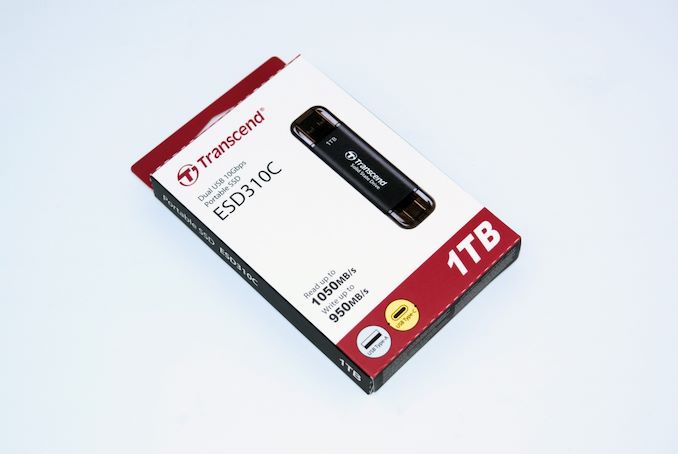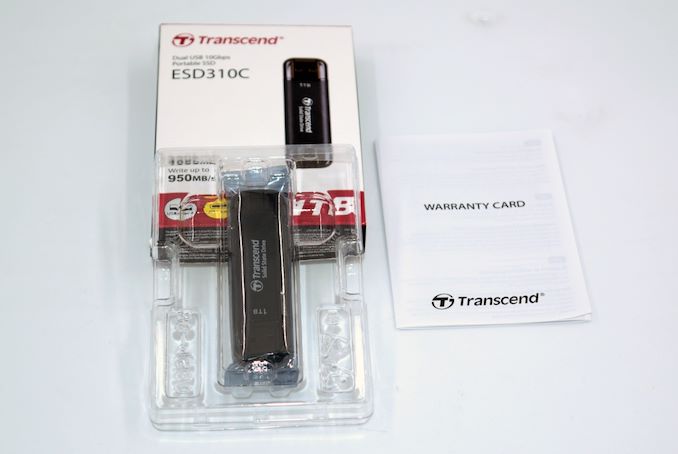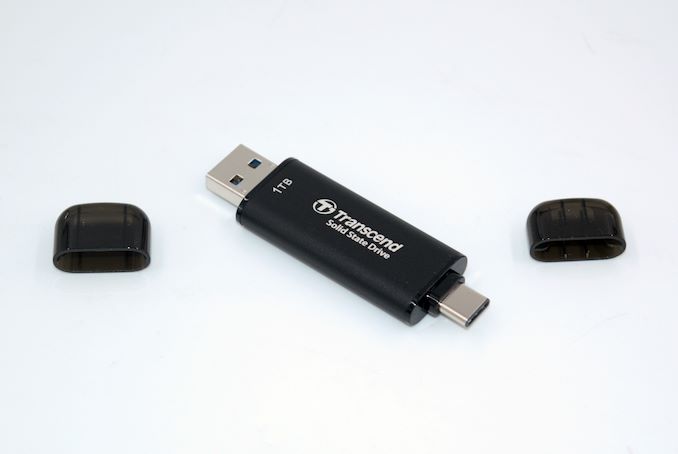Transcend ESD310C Dual-Interface UFD Review: Silicon Motion Powers Portable SSD in a Thumb Drive
by Ganesh T S on June 22, 2023 8:00 AM EST
Transcend is a well-known manufacturer of digital storage products, particularly in the industrial space. The company also has plays in the consumer segment, with products ranging from both internal and external SSDs to DRAM modules and card readers.
In April 2023, the company introduced the ESD310C - a portable SSD in a thumb drive form-factor. With claimed read speeds of up to 1050 MBps and write speeds of up to 950 MBps, the USB 3.2 Gen 2 makes its entry into the 10 Gbps-class PSSD market. The main differentiating aspect is the presence of both Type-A and Type-C interfaces. There are four capacity points - 256 GB, 512 GB, 1 TB, and 2 TB.
Kingston's DataTraveler Max had the first mover advantage in the high-performance thumb drive segment. The product line made its debut with a Type-C version, and the Type-A variant was introduced after a few quarters. In the meanwhile, other vendors have tried to differentiate themselves from the Kingston drive by introducing a sturdier version with both Type-A and Type-C interfaces. We took a comprehensive look at one such USB flash drive (UFD) - the OWC Envoy Pro Mini - earlier this year. Transcend's ESD310C attempts to play in the same dual-interface segment, but goes with a traditional thumb drive design and focus on pricing to appeal to a broader consumer base. This review takes a detailed look at the performance and value proposition of the 1 TB version of the new ESD310C, with a particular focus on how it stacks up against the existing players in the segment.
Introduction and Product Impressions
Bus-powered direct-attached storage devices have grown both in storage capacity and speeds over the last decade. The advent of 3D NAND and NVMe, along with faster host interfaces for external devices (such as Thunderbolt and USB 3.2 Gen 2x2), has enabled the introduction of palm-sized flash-based storage devices capable of delivering 2GBps+ speeds.
Prior to the introduction of SATA bridge-based PSSDs, the UFD market was dominated entirely by the thumb drive form factor. Vendors such as Corsair and Mushkin briefly experimented with SATA SSDs behind a USB bridge chip, but the thermal solution and size made the thumb drive UFDs unwieldy. The introduction of high-performance native UFD controllers in recent years from Phison and Silicon Motion has made this category viable again while providing better performance. The Crucial X6, equipped with the Phison U17, was reviewed in August 2021, but it was not a true thumb drive. In that particular category, Silicon Motion has enjoyed significant success, thanks to the popularity of the Kingston DataTraveler Max series (with separate SKUs for Type-C and Type-A drives).
In April 2023, Transcend introduced the ESD310C using essentially the same internals as the Kingston DataTraveler Max Type-A - Silicon Motion's SM2320 native UFD controller coupled with Kioxia's BiCS5 112L 3D TLC NAND. It attempts to differentiate itself from the other high-performance thumb drives based on the following aspects:
- Dual interface support in a single unit (both Type-A and Type-C)
- Reduced width to keep adjacent USB ports free for use
- Highly compact and lightweight
- Caps at either end to protect connectors from dust and accidental damage
Silicon Motion reached out to us for a review of the Transcend ESD310C as yet another vehicle to showcase the versatility of their UFD controller. The company sent across the 1 TB version of the portable SSD to put through our direct-attached storage test suite.
The industrial design of the ESD310C is typical of a thumb drive - a rectangular design with a metal body bookended by plastic tabs sporting the interface connectors. The protection caps are made of plastic. While the metal body provides some rigidity, the plastic caps and the overall lightweight / compact nature lends it a flimsy appearance.
This review will be comparing the ESD310C with a host of other 1 TB PSSDs in both the thumb drive and palm form-factors. CrystalDiskInfo provides a quick overview of the capabilities of the internal storage device. Since the program handles each bridge chip / controller differently, and the SM2320 has not yet found its way into the tracked controllers, many of the entries are marked as vendor-specific, and some of the capabilities (such as the interface) are deciphered incorrectly. However, other S.M.A.R.T features such as temperature read outs worked well.
| S.M.A.R.T Passthrough - CrystalDiskInfo | |
 |
 |
The table below presents a comparative view of the specifications of the different storage bridges presented in this review.
| Comparative Direct-Attached Storage Devices Configuration | ||
| Aspect | ||
| Downstream Port | Native Flash | 1x PCIe 3.0 x4 (M.2 NVMe) |
| Upstream Port | USB 3.2 Gen 2 Type-A (Male) + Type-C (Male) | USB 3.2 Gen 2 Type-C |
| Bridge Chip | Silicon Motion SM2320 | ASMedia ASM2362 |
| Power | Bus Powered | Bus Powered |
| Use Case | 1GBps-class, compact USB thumb drive with both Type-A and Type-C interfaces | 1GBps-class, IP67-rated rugged and compact portable SSD |
| Physical Dimensions | 71.3 mm x 20 mm x 7.8 mm | 76 mm x 52 mm x 12 mm |
| Weight | 11 grams | 85 grams |
| Cable | N/A | 64.8 cm USB 3.2 Gen 2 Type-C to Type-C Attached Type-C female to Type-A male adapter (resultant Type-C to Type-A cable length : 67.8 cm) |
| S.M.A.R.T Passthrough | Yes | Yes |
| UASP Support | Yes | Yes |
| TRIM Passthrough | Yes | Yes |
| Hardware Encryption | Not Available | N/A |
| Evaluated Storage | Toshiba BiCS5 112L 3D TLC | Kioxia (Toshiba) BiCS 4 96L 3D TLC |
| Price | USD 69 | USD 229 |
| Review Link | Transcend ESD310C 1TB Review | OWC Envoy Pro Elektron 1TB Review |
Prior to looking at the benchmark numbers, power consumption, and thermal solution effectiveness, a description of the testbed setup and evaluation methodology is provided.
Testbed Setup and Evaluation Methodology
Direct-attached storage devices (including thumb drives) are evaluated using the Quartz Canyon NUC (essentially, the Xeon / ECC version of the Ghost Canyon NUC) configured with 2x 16GB DDR4-2667 ECC SODIMMs and a PCIe 3.0 x4 NVMe SSD - the IM2P33E8 1TB from ADATA.
The most attractive aspect of the Quartz Canyon NUC is the presence of two PCIe slots (electrically, x16 and x4) for add-in cards. In the absence of a discrete GPU - for which there is no need in a DAS testbed - both slots are available. In fact, we also added a spare SanDisk Extreme PRO M.2 NVMe SSD to the CPU direct-attached M.2 22110 slot in the baseboard in order to avoid DMI bottlenecks when evaluating Thunderbolt 3 devices. This still allows for two add-in cards operating at x8 (x16 electrical) and x4 (x4 electrical). Since the Quartz Canyon NUC doesn't have a native USB 3.2 Gen 2x2 port, Silverstone's SST-ECU06 add-in card was installed in the x4 slot. All non-Thunderbolt devices are tested using the Type-C port enabled by the SST-ECU06.
The specifications of the testbed are summarized in the table below:
| The 2021 AnandTech DAS Testbed Configuration | |
| System | Intel Quartz Canyon NUC9vXQNX |
| CPU | Intel Xeon E-2286M |
| Memory | ADATA Industrial AD4B3200716G22 32 GB (2x 16GB) DDR4-3200 ECC @ 22-22-22-52 |
| OS Drive | ADATA Industrial IM2P33E8 NVMe 1TB |
| Secondary Drive | SanDisk Extreme PRO M.2 NVMe 3D SSD 1TB |
| Add-on Card | SilverStone Tek SST-ECU06 USB 3.2 Gen 2x2 Type-C Host |
| OS | Windows 10 Enterprise x64 (21H1) |
| Thanks to ADATA, Intel, and SilverStone Tek for the build components | |
The testbed hardware is only one segment of the evaluation. Over the last few years, the typical direct-attached storage workloads for memory cards have also evolved. High bit-rate 4K videos at 60fps have become quite common, and 8K videos are starting to make an appearance. Game install sizes have also grown steadily even in portable game consoles, thanks to high resolution textures and artwork. Keeping these in mind, our evaluation scheme for portable SSDs and UFDs involves multiple workloads which are described in detail in the corresponding sections.
- Synthetic workloads using CrystalDiskMark and ATTO
- Real-world access traces using PCMark 10's storage benchmark
- Custom robocopy workloads reflective of typical DAS usage
- Sequential write stress test
In the next section, we have an overview of the performance of the Transcend ESD310C 1 TB drive in these benchmarks. Prior to providing concluding remarks, we have some observations on the UFD's power consumption numbers and thermal solution also.













27 Comments
View All Comments
ganeshts - Thursday, June 22, 2023 - link
Pretty much the only pen drives that will hold up to accidents when connected to a USB port are ones like the SanDisk Ultra Fit, Samsung FIT, and Mushkin Atom. These already achieve the perf you can get from micro-SD cards with tiny card readers and are more compact.meacupla - Thursday, June 22, 2023 - link
I am hoping 2242 enclosures become more popular, because all I can find are 2280JaqenHghar - Thursday, June 22, 2023 - link
Nice 2230 enclosure, USBC onlyhttps://www.kickstarter.com/projects/shargetech/sh...
ceisserer - Friday, June 23, 2023 - link
> SanDisk Ultra Fit, Samsung FIT, and Mushkin Atom.> These already achieve the perf you can get from micro-SD cards
Unfortunetly not when it comes to random write performance, all those tiny drives use "traditional" controllers which suffer a lot. At least some microsd cards are a bit better thanks to the A2 rating. Furthermore the FIT is limited to 256GB, whereas the Sandisk is extremly slow and tops out at 512GB.
I understand that those small form factors mean thermal limitations, but UFS chips show what is possible with very little power. Why not solder an UFS chip + usb bridge on a small PCB? A lot of performance with off-the-shelf components. I doubt there isn't a market for that.
Skeptical123 - Saturday, June 24, 2023 - link
I've looked for something like that too. It is not really possible and even then simply too niche. "Why not solder an UFS chip + usb bridge on a small PCB?" that heat has to go somewhere ie a heat sink ie bigger case.jaydee3839 - Friday, June 23, 2023 - link
To me, the most interesting aspect is use as a bootable thumbdrive. Most typical flash USBs are fast enough, but fail quickly because of all the small random writes. When I was searching for a thumb drive form factor SSD a few months ago for this, I didn't see anything close to this for the $/GB.garblah - Friday, June 23, 2023 - link
I see the 5 year limited warranty quoted everywhere but no TBW rating listed anywhere. Maybe there's no total data written limit accompanying the warranty?GreenReaper - Sunday, June 25, 2023 - link
This is a very reasonable complaint as "SSD products and memory cards are covered by the Warranty Service only when the S.M.A.R.T. analysis tested by Transcend is greater than 0%." - https://us.transcend-info.com/Legal/?no=17Perhaps Ganesh could obtain clarification as to this detail (or the SMART data may imply an answer, comparing the raw value of e.g. bytes written vs. the lifetime score).
abufrejoval - Saturday, June 24, 2023 - link
Been using the Kingston Data travellers a lot, both in 250GB and 1TB variants as a replacement for replaceable SATA SSDs, which I keep in trayless docks on my workstations.They are actually twice as fast those SATA and much more flexible.
Only disadvantage is that they quite literally stick out, which can be a bit of a hazard. I used mostly the USB-C variant and then an adapter to fit them into USB-A where required, the other way around with a cable reduces the "stick out" a bit, but that doesn't really help portability, either. So the single device with both ports is definitely a plus but I like those SANdisk devices, where you have a slide-out for USB-A and USB-C and a neutral position hiding both... I guess these would be a bit unwieldy for this as their much more powerful internals can't quite fit in to that form factor (yet).
Makes you wish notebooks had a dock to hide them in just like the older notebooks could usually convert a CD/DVD/BD drive in to a SATA SSD caddy, which I used extensively to switch between operating systems.
All other things being equal, I guess the next round will be Transcend for the form factor advantages, especially the side-by-side mounting, which has been an issue on various notebooks.
A 2TB variant is greatly appreciated but pricing needs to be in line with NVMe, which is dropping very quickly.
These drives pretty much kill NVMe-2-TB storage adapters for me, as most of those only allow 2 lanes of PCIe 3.0 anyway and have turned out to die rather quickly, too. And with the equivalent of 2TB of storage in asking price, they are now really just about being able to copy NVMe media, without having to tear apart the temporary host.
Now we just need proper JBOD/RAIDx for them!
Viji - Tuesday, June 27, 2023 - link
ordered mine from Amazon , it ships from Japan